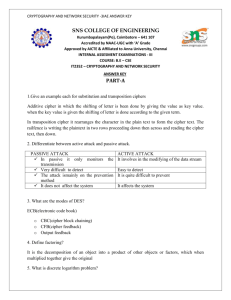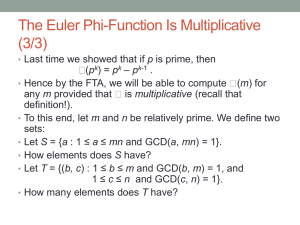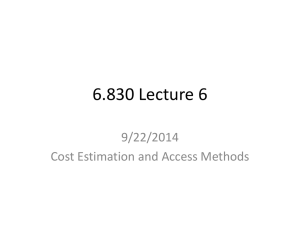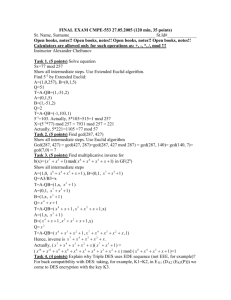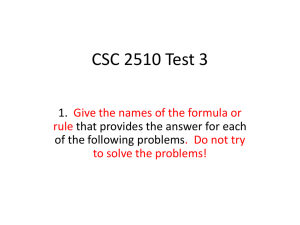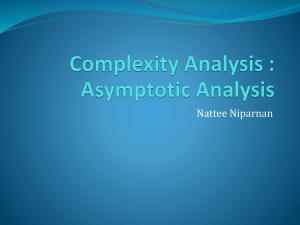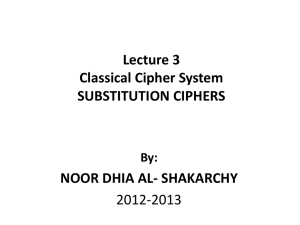Lecture note 9
advertisement
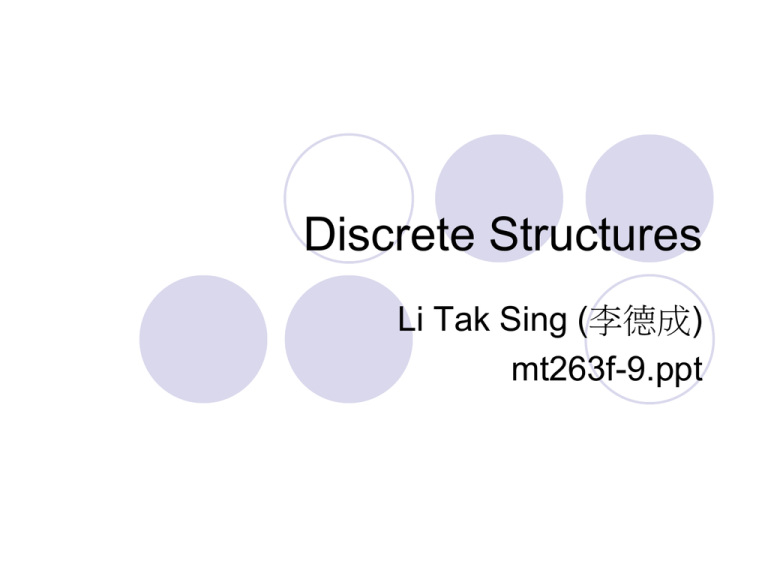
Discrete Structures
Li Tak Sing (李德成)
mt263f-9.ppt
Pigeonhole principle
If m pigeons fly into n pigeonholes where
m>n, then one pigeonhole will have two or
more pigeons.
Examples in pigeonhole principle
How many people are needed in a group to say
that three were born on the same day of the
week?
How many people are needed in a group to say
that four were born in the same month?
Why does any set of 10 nonempty strings over
{a,b,c} contain two different strings whose
starting agree and whose ending letters agree?
Find the size needed for a set o nonempty
strings over {a,b,c,d} to contain two strings
whose starting letters agree and whose ending
letters agree.
The Mod function and inverses
Let n>1 and let f:NnNn be defined as
follows, where a and b are integers.
f(x)=(ax+b)mod n.
Then f is a bijection iff gcd(a,n)=1. When
this is the case, the inverse function f-1 is
defined by
f-1(x)=(kx+c) mod n
where c is an integer such that f(c)=0, and
k is an integer such that 1=ak+nm for
some integer m.
1=ax+by
Given that gcd(a,b)=1, then there are x,y
such that 1=ax+by
For example, gcd(10,7)=1,
first we have 10=1*7+3
then we have 7=3*2+1
therefore we have 2*10=2*7+(7-1)
2*10=3*7-1
1=3*7-2*10
Example
Find a,b so that 7a+5b=1
Find a,b so that 7a+11b=1
Simple ciphers
N26={0,1,..25} represents letters {a,...,z}
We can use a function to transform a letter
to another. For example
f: N26N26, f(x)=(x+5) mod 26
The inverse of f, denoted as f-1, is:
f-1(x)=(x-5) mod 26
f is known as a cipher which would
transform a letter into another letter to hide
secret.
Multiplicative cipher
The previous cipher is called an additive
cipher because addition is use.
A multiplicative cipher is one that
multiplication is used.
An example is:
g(x)=3x mod 26
the inverse is g-1(x)=9x mod 26
Example
Determine where the following functions
define a cipher. If a function is a cipher,
then find the inverse function
f(x)=2x mod 6
f(x)=2x mod 5
f(x)=5x mod 6
f(x)=(3x+2) mod 6
f(x)=(2x+3) mod 7
Hash function
A hash function is a function that maps a
set S of keys to a finite set of table
indexes, which we'll assume are 0,1,...,n1. A table whose information is found by a
hash function is called a hash table.
Hash example
For example, let S be the set of threeletter abbreviations for the months of the
year. We might define a hash function
f:S{0,1,..,11} in the following way.
f(XYZ)=(ord(X)+ord(Y)+ord(Z))mod 12.
where ord(X) represents the ASCII code
for X.
One use of hash functions
Assume that you have a table of m entry and
you want to store some items in the table. Each
item has a key which can be used to uniquely
identify it. Now, we can use a hash function so
that it will generate an index for the item to be
stored in the corresponding entry.
This method has an advantage that when we
know of the key, we can find the position where
the item is stored.
Collisions
If the numbers of objects to be stored is
greater than the size of the table, then
collision must occur.
One technique to solve the problem of
collision is called linear probing. With this
technique the program searches the
remaining locations in a linear manner.
Hash examples
Let S={Monday, Tuesday, Wednesday,
Thursday, Friday, Saturday, Sunday} and
suppose that f:SN7 is the hash function
defined by f(x)=lenght(x) mod 7 where
length(x) is the number of letters in x. Use
h to place each day of S into a hash table
indexed by {0,1,..,6} starting with Monday,
then Tuesday, and so on until Sunday.
Resolve collisions by linear probing with a
gap of 2.

